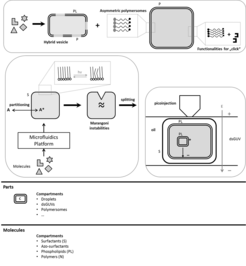Compartments
Work Package T1
There is a clear consensus in the community of pre-biotic chemistry and in Synthetic Biology that compartments are essential for the apparition of life1 as “all life on Earth is cellular, namely based on closed compartments”2.
The role of compartments in the apparition of life has been clearly stated by Oparin3. Even if prebiotic chemistry would enable the synthesis of macromolecules, the sole synthesis of the molecules is not sufficient: “if mononucleotides are polymerized in isolated solution, we simply get an accumulation of polynucleotides which under natural conditions would yield deposits of the substances”3. However, in the presence of other polymers such as polypeptides, “individual systems” or compartments can be found in suspension. These are denoted as protenoids (or Fox) microspheres, have a size of a few microns and a double membrane-like structure3. Already then, Oparin proposed a Synthetic Biology approach of this observation and produced coacervate droplets as artificial minimal models for the Fox microspheres up to the point where these coacervate droplets could grow, driven by enzymatic synthesis of starch3. Coacervates provide means to increase the concentrations from dilute solutions thereby enhancing the efficiency of chemical reactions. As a note, cells make use of this property with the assembly of e.g. stress granules or P-granules, which will be ingredients studied in this project cluster. In the past 50 years, progress beyond was hindered by challenges both in biochemistry and in the fabrication and manipulation techniques for microcompartments. The advent of modern microfluidics combined with the rapid advances in biophysics and biochemistry now allow for the first time a systematic approach.

Another important property of compartments is to provide boundaries and hence means to avoid/reduce diffusion and dilution of products. For example, interfacial catalysis or evaporation processes leading to the decrease of the size of the microcompartment also increase concentration, thereby favouring reactions4. It also provides a link between the genotype and the phenotype when the catalytic molecules (e.g. enzymes) are different from the replicating molecules (carrying the information). Such a link is required to guarantee that the encoding molecules are selected when they provide a selective (catalytic) advantage.
In a Bottom-up Synthetic Biology approach, controlling microcompartments is essential. Work Package T1 deals with the formation, characterization and manipulation of biomimetic microcompartments. We will continue to use microfluidic technology to produce these compartments from a library of chemical systems that includes droplets, vesicles and polymersomes. We are generating, understanding and controling individual compartments with well-defined and well-controlled physico-chemical properties and functions. We are designing artificial systems with minimal but sufficient functions to serve as artificial biomimetic compartments with cell-like properties. In our bottom-up approach, the complexity of the compartment is gradually increased. We start from functionalized interfaces in droplets (most basic microcompartments), vesicles (membrane-based microcompartments) or polymersomes (synthetic membranes usable for controlled chemical functionalization). Emphasis will be given to the control of the (bio)-chemistry and the physical properties of their interfaces. The microfluidic scheme will be optimized for the controlled, reproducible and high-throughput production of the compartments. We will quantify and characterize the physico-chemical properties with established techniques for colloids and interfaces characterization, and theoretical modelling.
Essential to living systems is the necessity to exchange materials with its surrounding2. Microcompartments therefore need not to be closed, but the selective transport in and out of the compartments is essential. Energy supply, metabolism, chemical sensing, waste removal, and compartment-compartment communication must be possible while not losing essential inter-compartmental functions. We shall design and investigate different transport mechanisms, characterize these in detail and use this information to improve our design. We will design systems, where the interfacial properties of a microcompartment can be externally controlled through, for example, light, temperature or electric field. The understanding and control of the interfacial properties will be key for the optimal design of non-equilibrium and self-organized systems (see Project Cluster L).
MaxSynBio Network Partners
References
1 Mann, S. (2013). The Origins of Life: Old Problems, New Chemistries. Angewandte Chemie-International Edition, 52(1), 155-162
2 Luisi, P. L. (2006). The Emergence of Life From Chemical Origins to Synthetic Biology Preface. Emergence of Life: From Chemical Origins to Synthetic Biology, Xi-+
3 Oparin, A. I. (1965). The origin of life and the origin of enzymes. Adv Enzymol Relat Areas Mol Biol, 27, 347-380
4 Dobson, C. M., Ellison, G. B., Tuck, A. F., & Vaida, V. (2000). Atmospheric aerosols as prebiotic chemical reactors. Proceedings of the National Academy of Sciences of the United States of America, 97(22), 11864-11868
